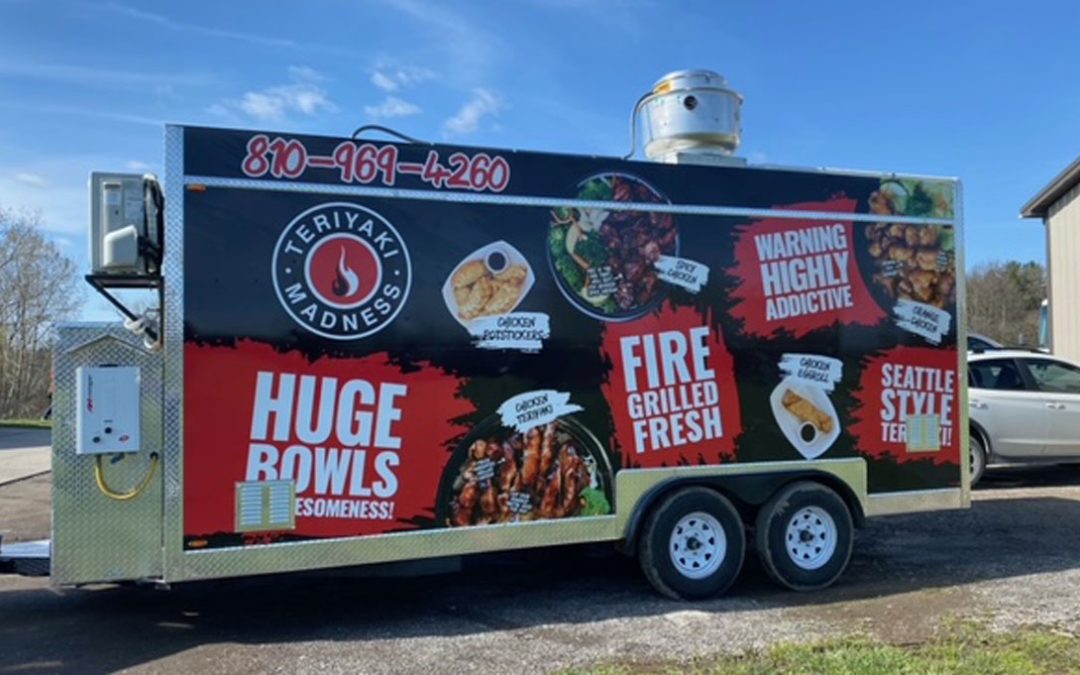One Teriyaki Madness operator is pushing her off-premises proclivity outside the restaurant in a food truck test. The test is part marketing, part operations and potentially a new revenue driver—but that depends on the event.
For Teriyaki Madness CMO Jodi Boyce, it’s a great way to get out into the community and reach new people. To her, the truck is a way to help people who might not be near a restaurant or who don’t know the brand to try it for the first time.
“We know from our research customers love Teriyaki Madness for the flavor, it’s craveable and something I can’t make at home,” said Boyce. “We know when we get people to try the food, they’ll get it and understand what the brand is. So, this is a great way to get the brand awareness out there and let people try the food.”
For Katie Caitlin, a one-location franchisee in Michigan, that’s something she hears in the restaurant, but getting out into the community helps her reach more and more people for the first time.
“We did a food truck last week, it was slow. I but I got 10 people to come try me and they said, ‘I can’t believe I haven’t tried these guys,’” said Caitlin.
She said the mobile kitchen is wrapped with branding and enticing menu items, and the staff is primed to move fast—nipping the common gripe of slow food-truck food in the bud.
As she noted, there’s a lot of learning to do as she ramps up the food truck. Much of the event business is out of her control. She went to a popular food truck event, hoping for a blockbuster day based on what event planners promised.
“I asked the guy, he said, ‘pre-COVID we had 40,000 people, since COVID, it’s 20,000,’” said Caitlin. “Only 2,000 people bought tickets, so they inflate that. I’m learning form that. If they tell you 1,000, knock one zero off the number.”
That’s been true for a lot of the big-name events. She’s documenting the disparities there, but also leaning into new post-COVID ways of community gathering, essentially catering from the vehicle. For every mediocre festival, there’s a surprisingly fruitful event. One was a subdivision that started hosting food trucks at a community pool. It sounded small, but Caitlin said she sold out of everything in just two hours.
A big part of her prep is figuring out how much and what food to bring so it’s not wasted. For that event, she brought the right amount for the number of sales, but it “must have been a very health-conscious community, every bowl was a Power Bowl. All the veggies were gone in the first hour,” said Caitlin, referencing the bowls that replace rice with more veggies.
The menu got a bit of a trim for the mobile kitchen, as well.
“We don’t have a huge menu to begin with, we try to focus on our core and do that well. We took our three top selling products, Teriyaki, Spicy Chicken and our Orange Chicken. You still get the choice of white or brown rice and noodles, and all the bowls come with our stir fry veggies,” said Boyce. “We limited the truck to a few items and one appetizer, our egg roll. It’s limited to ensure throughput and make sure the space in the food truck can handle that.”
Caitlin said that’s all as fast as the brick-and-mortar location with three people. More than that, things slow down because there are literally too many cooks in the kitchen.
There are other costs to think about. Labor is a bit of a trick because Caitlin has to pay drive time and clean-up time. Volatile gas prices have increased expenses, but also created opportunities for her to swoop in on events where another truck canceled.
“I’ve learned because food trucks are cancelling a lot because gas is so high. I’m not paying to play. If you’re calling me and you need me, you’re going to waive any fees because I have other things I can do,” said Caitlin. “The gas thing is huge, that’s how I picked up an event last night, she had food trucks not showing up.”
Caitlin said she’s booked through the fall with events almost every weekend. Once the food-truck season ends in Michigan, she’ll look at some more corporate catering-style events with the mobile kitchen and tally everything up.
She and Boyce are watching revenue to see if it makes strong business sense, but also looking to track if some of those new people are actually coming into the restaurants. Anecdotally, the roving Orange Chicken billboard has brought a few people in.



